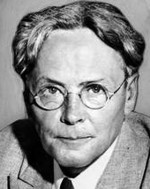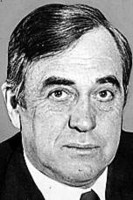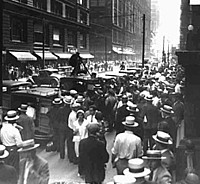|
JUDGE JAMES H. WILKERSON
A Mount Ayr Native

The legendary St. Valentine's Day Massacre, occurring during the height of the Prohibition era in 1929, has been the
subject of countless articles, books, films and speculation over the decades.
The years leading up to the morning of February 14, 1929, were like a simmering pot of water on the brink of boiling
as Alphonse "Scarface Al" CAPONE and his south-side Italian gang fought George "Bugs" MORAN and his north-side Irish-
German gang to gain control of Chicago. Then CAPONE's henchman, Jack "Machine Gun" McGURN came up with the ideal plot
to put "Bugs" MORAN in his place. Six of CAPONE's men, two of whom were disguised as Chicago policemen, converged upon a
Clark Street garage and, in cold blood, gunned down seven confused members of MORAN's gang.
"Bugs" MORAN was unfashionably late for the gathering that morning, however it saved his life. When he noticed the
police racing to the garage and had his driver drive on.
The publicity surrounding the St.
Valentine's Day Massacre quickly became a national media event. Although CAPONE had assured himself of an air-tight
alibi by being in Florida, and McGURN had been conveniently holed up in a hotel with his blonde "alibi",
everyone knew they were responsible for the massacre as surely as if they had pulled the triggers themselves.
It was more than the law-abiding citizens of Chicago would tolerate. The federal government and Iowa-born President
Herbert H. HOOVER agreed. Something had to be done. President HOOVER turned to United States district attorney, George
E. Q. JOHNSON, another native from Iowa.
 The son of Swedish homesteaders, George E. Q. JOHNSON was born on a farm near Lanyon and Harcourt, Iowa, on July 11, 1874.
In 1897, he graduated from Tobin College, Fort Dodge, and received his law degree in 1900 from Lake Forest University, Illinois.
JOHNSON practiced law in Chicago until 1927.
The son of Swedish homesteaders, George E. Q. JOHNSON was born on a farm near Lanyon and Harcourt, Iowa, on July 11, 1874.
In 1897, he graduated from Tobin College, Fort Dodge, and received his law degree in 1900 from Lake Forest University, Illinois.
JOHNSON practiced law in Chicago until 1927. Although he was the target of numerous death threats coming from the
criminal faction, JOHNSON worked diligently, securing indictments against CAPONE and 68 of his henchmen.
CAPONE faced twenty-two counts of tax evasion which totaled over $200,000. Then, on June 12, 1931, based upon
evidence produced by Eliot NESS and his team, a third indictment was returned, charging CAPONE and his henchmen
with some 5,000 separate violations of the Volstead Act. Many of those charges dated back to 1922. However, in typical
governmental protocol, the tax
case took precedence over any Prohibition violation. If convicted, CAPONE faced a possible 34-year sentence.
His attorneys presented JOHNSON with a deal. CAPONE would plead guilty in exchange for a relatively light sentence. After discussing
the matter over with the newly seated Treasury Secretary Ogden MILLS and Elmer L. IREY of the IRS Special
Intelligence Unit, JOHNSON agreed to accept the deal and
recommend a sentence of between two to five years. CAPONE appeared at court on June 16th, a happy man who believed
that he would take a light slap on the wrist, pay his dues, and be back to business as usual in a relatively short time
considering what he could be facing. Seated on the bench was Federal District Judge James H. WILKERSON. Judge
WILKERSON adjourned the hearing until June 30. CAPONE left the courtroom and told the press that he was seriously
entertaining offers from movie studios to make a film of his life.
 Born December 11, 1860 in Savannah, Missouri to schoolmaster Professor and Mrs. J. W. WILKERSON, Judge James Herbert WILKERSON grew up in Mount Ayr, Ringgold
County, Iowa. WILKERSON obtained his degree from DePauw University in 1889. As a young man starting out, Judge WILKERSON practiced law in Robert
SPENCE's law office in Mount Ayr before setting up the Chicago law firm of Wilkerson, Cassels, Potter and Gilbert in 1893. WILKERSON served as a member of
the Illinois House of Representatives in 1902, followed by a term as Cook County Attorney from 1903 to 1904.
From 1906 to 1911, WILKERSON was a special assistant to the Attorney General of the United States, then as U.S.
Attorney for the Northern District of Illinois from 1911 to 1914. From 1919 to 1921, WILKERSON was the chairman of the
Public Utilities Commission for the State of Illinois.
Born December 11, 1860 in Savannah, Missouri to schoolmaster Professor and Mrs. J. W. WILKERSON, Judge James Herbert WILKERSON grew up in Mount Ayr, Ringgold
County, Iowa. WILKERSON obtained his degree from DePauw University in 1889. As a young man starting out, Judge WILKERSON practiced law in Robert
SPENCE's law office in Mount Ayr before setting up the Chicago law firm of Wilkerson, Cassels, Potter and Gilbert in 1893. WILKERSON served as a member of
the Illinois House of Representatives in 1902, followed by a term as Cook County Attorney from 1903 to 1904.
From 1906 to 1911, WILKERSON was a special assistant to the Attorney General of the United States, then as U.S.
Attorney for the Northern District of Illinois from 1911 to 1914. From 1919 to 1921, WILKERSON was the chairman of the
Public Utilities Commission for the State of Illinois. On July 11, 1922, James Herbert WILKERSON was nominated by President Warren G. HARDING
to take a seat vacated by Federal Judge Kenesaw M. LANDIS. [Judge LANDIS stepped down to accept a position
as the Commissioner of Baseball.] WILKERSON's nomination was
confirmed by the Senate July 18, 1922, and received his commission on July 18, 1922. As a Federal Judge, James Herbert WILKERSON handed down a mandate that
smashed the railway shopmen's strike in 1922. This mandate restrained strikers all over the nation from meeting,
picketing, and agitating against their employers. Regardless of criticism over his labor relations, Judge WILKERSON became somewhat of a judicial hero
when he began sending gangsters to prison. In 1925, President HOOVER appointed James Herbert WILKERSON to the
Circuit Court of Appeals in Chicago. This Presidential appointment was a reward for his "splendid service" in
curbing gang activities. Judge WILKERSON had a surprise for CAPONE when he returned to court on June 30 of 1931.
Judge WILKERSON said firmly, "The parties to a criminal case may not stipulate as to the judgment to be entered."
Although he would listen to JOHNSON's recommendations, Judge WILKERSON made it perfectly clear that he was not under
any obligation to go along with any plea bargain or negotiation. CAPONE was totally shocked. Judge WILKERSON drove home his point, stating,
"It is time for somebody to impress upon the defendant that it is utterly impossible to bargain with a federal court."
Now CAPONE was worried and it showed. Judge WILKERSON said he would allow CAPONE an opportunity to withdraw his guilty
plea and scheduled his trial to commence on October 6th. CAPONE retreated to his old hideout in Lansing, Michigan. Meanwhile, his
gang procured a list of prospective jurors and began attempts to bribe them by every possible means. JOHNSON
presented evidence of the behind-the-scenes bribery to Judge WILKERSON. Judge WILKERSON appeared to be neither concerned
nor surprised, saying, "Bring your case to court as planned, gentlemen. Leave the rest to me."
Security was exceedingly tight at the Federal Court Building on October 6th of 1931. Dressed in a conservative blue serge
suit and leaving his pinkie rings at home, CAPONE was escorted through a tunnel to a freight elevator. One journalist
asked CAPONE, "Are you worried?" Grinning, CAPONE replied, "Worried? Well, who wouldn't be?" However CAPONE was
quite confident, believing that his men had gotten to the jury. All he had to do was show up in court each day,
be polite and respectful, and he would be acquitted. Of course he'd be sure to tell the press that he harbored no ill
will. After all, the government boys were only doing their job. The government's team consisted of
U.S. Attorney George E. Q. JOHNSON and prosecutors Samuel CLAWSON, Jacob GROSSMAN, Dwight GREEN, and William FROELICH.
Judge WILKERSON entered the courtroom sans his robes, wearing only his dark suit. Upon taking his place at the bench he said, "Judge EDWARDS
has another trial commencing today. Go to his courtroom and bring me the entire panel of jurors. And, take my entire
panel to Judge EDWARDS." Everyone in the courtroom, especially CAPONE and his attorney Michael AHERN, was shocked and dazed.
The new panel of jurors, mostly white men from rural areas, had never appeared on any of the lists of potential jurors for
Judge WILKERSON's courtroom. To assure that they would not be approached by any of CAPONE's men and remain untarnished, the jurors would
be sequestered at night.
Judge WILKERSON's Last Minute Jury
Late on Saturday night of October 17th, 1931, and after nine hours of deliberation, the jury
found CAPONE guilty of some of the tax evasion counts against him. On October 24th, Judge WILKERSON gave
CAPONE an eleven-year sentence to be served out at the federal penitentiary in Atlanta. Judge WILKINSON also
tacked on a fine of $50,000 plus court costs. Judge WILKERSON's final blow was to deny bail. CAPONE would be
incarcerated immediately at the Cook County Jail until his removal to the penitentiary. CAPONE was visably shaken.
He licked his lips. He jiggled on his feet. His fingers, locked tightly together behind his back, twitched
and twisted. As CAPONE left Judge WILKERSON's courtroom, an offical from the IRS slapped liens on his property to
satisfy their tax claims. CAPONE lost his temper and attempted to attack the agent. However the marshals kept their prisoner
tighly restrained. CAPONE's henchmen, which included
his brother Ralph "Bottles" CAPONE, Frank "the Enforcer" NITTI, and gambling chief Jack GUZICK received prison sentences,
too. Thus, Chicago's gangs were splintered by the swift and sharp report of a judicial gavel.


At right: Crowds outside the Federal Building during the Capone Trial, and Headlines upon
Capone's conviction.
The Rest of the Story
Although President HOOVER appointed JOHNSON as a federal judge on August 3, 1932, a lame-duck Congress delayed confirmation
of this appointment. JOHNSON's service ended March 3, 1933. Saddened by the turn of events, JOHNSON returned to
private practice. On September 19, 1949 at the age of 75, George E. Q. JOHNSON died of a brain hemorrhage in his Chicago
home. Among his survivors was his son, George Jr. Judge WILKERSON assumed senior status in the federal
judicial system on December 31, 1940. His service terminated upon his death from heart disease at the age of 79. Judge
WILKERSON died in Evanston,
Illinois on September 30, 1948. Although CAPONE began his sentence in Atlanta, word leaked out that he was living like a king and still
running his operations behind prison bars. In August of 1934, CAPONE was sent to Alcatraz Federal Penitentiary. Attorney
General Homer CUMMINGS, who took over Alcatraz, said, "Here may be isolated the criminals of the vicious and irredeemable
type so that their evil influence may not be extended to other prisoners." Isolated CAPONE was behind bars at Alcatraz. He couldn't
run anything or even know what was happening on the outside. There were no smuggled letters or messages coming in or going
out of Alcatraz. As a young man, CAPONE had contracted syphilis. The disease was taking its toll by 1938. CAPONE had become
confused and disoriented. CAPONE died of cardiac arrest brought on by complications of syphilis in his Palm Island
palace on January 25, 1947. He was 48-years-old.
After the CAPONE era, several gangs continued to operate in Chicago but none were able to regain the power and control experienced during the 1920's.
Alcatraz, 2004

SOURCES:
LONGDEN, Tom. "Famous Iowans" The Des Moines Register, Des Moines, Iowa.
BARDSLEY, Marilyn. "Al Capone" www.trutv.com/library/crime/gangsters_outlaws/mob_bosses/capone/index_1.html
"Labor & Crime v. Wilkerson" Time Magazine, Monday, April 11, 1932.
www.deyoungmatson.com/Wilkerson/documents/judge_james_herbert_wilkerson.htm
Photographs from the National Archives, Washington, D.C.
Photograph of Alcatraz taken by Sharon R. Becker in 2004
Written and submitted by Sharon R. Becker, September 26, 2008


| 

